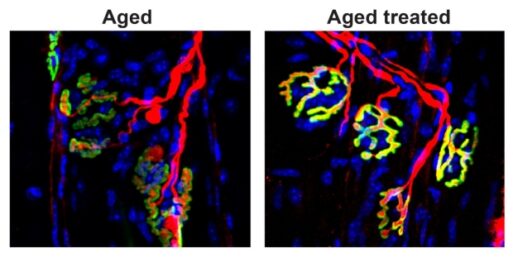
As we age, our muscles begin to weaken, increasing difficulty in performing everyday tasks. Muscle weakness can make older adults more prone to falling and reduce levels of independence despite sharp cognitive functioning. But now, research conducted by Stanford University’s Blau Laboratory has unveiled groundbreaking insights into the role of the enzyme 15-PGDH in muscular degeneration associated with aging. The study’s findings hold significant promise for potential future treatments aimed at restoring muscles damaged by injury or aging.
The Study
In previous research, Blau Laboratory identified 15-PGDH as a crucial enzyme that accumulates in aging muscles, referring to it as a “gerozyme” due to its heightened presence in aging bodies. It was in these early stages of research they discovered that inhibiting the enzyme’s activity increased leg strength in aging mice.

In older mice treated with an inhibitor of the enzyme 15-PGDH (right panel), the connections between a motor neuron (red) and receptor clusters on the muscle (yellow-green) are stronger compared to control mice (left panel).
Credit: Blau Lab via Stanford Medicine
Unsure why inhibiting 15-PGDH had such an effect on muscular regeneration, they continued to experiment, altering the presence of the enzyme in mice. The study revealed that 15-PGDH disrupts communication with PGE2, a molecule essential with muscle repair and mass increase. This relationship made sense to scientists. As we grow older, there is an accumulation of 15-PGDH in our muscles, leading to weakened muscles due to disrupted communication with PGE2, the enzyme responsible for muscle repair.
Blau Laboratories newest research showed that when 15-PGDH molecules are blocked in mice who have had nerves in their leg cut, the nerve grew back more quickly. Additionally, using a treatment with the drug showed restoration of neuromuscular junctions that had been lost due to aging. Their findings suggest that inhibiting 15-PGDH molecules restores lost connections between nerves and muscle fibers. By blocking 15-PGDH, which breaks down the muscle repair molecule PGE2, PGE2 is allowed to do its job and restore aging muscles. Conversely, when they increased levels of 15-PGDH in young mice, their muscles began to age rapidly.
Implications
Blau Laboratory’s findings are the first research to show that damaged motor neurons can be driven to regenerate using a drug treatment. The researchers are planning to experiment on people with spinal muscular atrophy to see if they can increase their muscular strength using their treatment.
If proven effective on humans, the widespread use of this treatment could mean extending older adults’ years of independence and reduced strain on the medical industry.

 New Research Reveals Pathways to Restore Aging Muscles
New Research Reveals Pathways to Restore Aging Muscles


 “Help Me, Helen”
“Help Me, Helen”
 Recovering Cremation Remains After the Los Angeles Fires
Recovering Cremation Remains After the Los Angeles Fires
 “As Tears Go By” by Marianne Faithfull
“As Tears Go By” by Marianne Faithfull














